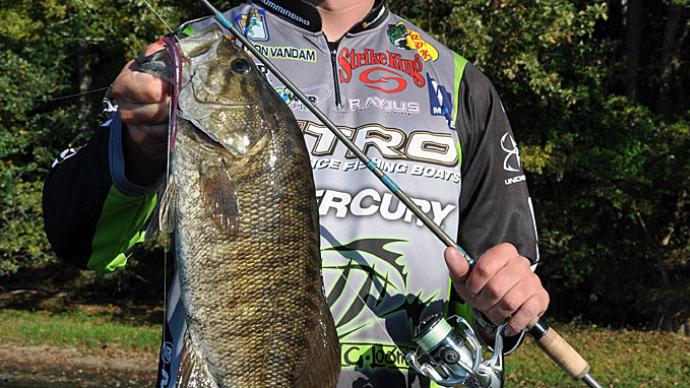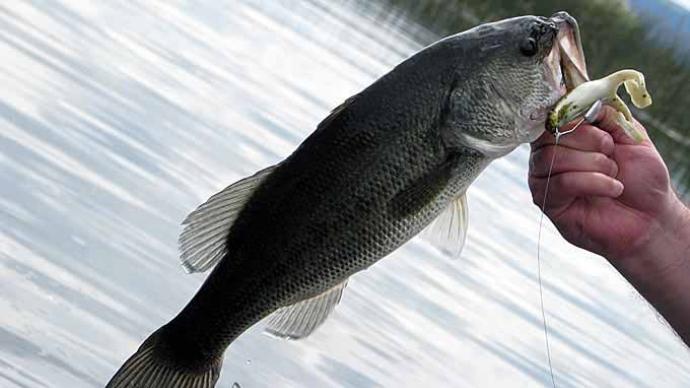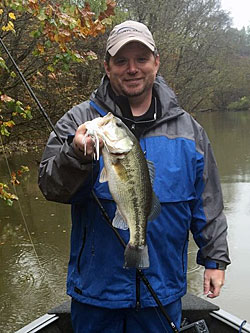
Lake Augusta is north of Harrisburg, Pa., where the west and main branches of the Susquehanna River meet. The world’s longest inflatable dam forms the 4-mile-long section of the river. While it’s called a lake, it’s more like a shallow pool filled with smallmouth bass. There always is current, which increases the farther you move away from the dam.
Smallmouth roam when the river is low and clear, using the midriver structure and cover to ambush crawfish and baitfish. Those rocks and logs are visible to anglers, and a well-placed soft-plastic lure will catch the smallmouth hiding behind them. Smallmouth head to current breaks on the bank when the water rises. Spinnerbaits cast rings their dinner bell against the shore. They are the same smallmouth, but the amount of current makes them act very different.
Current is the natural movement of water downhill. While the current is constant, its velocity is far from consistent. Rain and runoff can ramp it up, turning a gentle river into a torrent the shade of chocolate milk. Summers with little rain do the opposite, bringing rivers almost to a standstill. That variability demands a different approach than fishing in lakes and reservoirs. Current can make finding bass easier, but fishing for them is tougher.
River current is not entirely the same as the current generated by the outflow or inflow of water from power generation. That’s often the key ingredient in firing up bass in reservoirs — especially those along the Tennessee River. And tidal rivers, whose currents flow in opposite directions four times each day, are a different ball game.
Seams, slack water, and eddies
Everyone knows backwaters along a river can harbor big bass, especially during the spawn. But you can catch as many bass — smallmouth, largemouth, and spots — that are just as big from the main river if you understand how to use the river’s current to your advantage. When wind or waves are calm, look across a river; its surface will look different in different spots. Some places will be swirling, some calm and others moving. Each reveals what’s going on under the surface and points to bass.
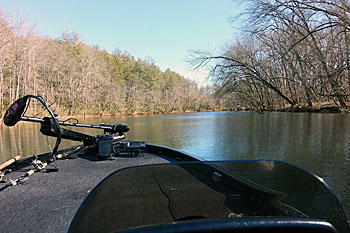
Swirling or boiling water gives away an underwater object. It could be a rock or log. In smaller rivers, it could be a rock vein that goes completely across the river bed. On larger rivers, there could be boils here and there but not necessarily by the bank. Whatever it is, it’s forcing the water up and over, which causes the disturbance. The current is faster and stronger on the upstream side of the disturbance than downstream. While it’s rare that you will fish the disturbance, it does dictate where you will.
Slack water will form downstream from the swirl. This is where bass are most likely to hold because they are protected from the current’s full force. The stretches where fast water meets slow, which radiate downstream on both sides of the break, are called seams. Bass use them as edges, resting in the calmer water and darting into the faster water to grab a meal. Expect to find the largest bass — especially smallmouth — closer to the current break. That’s the prime feeding place. Smaller bass are often forced downstream, where the seam isn’t as defined.
Current breaks also can be formed by visible cover such as a logjam. It will offer the same slack water, though if it’s attached to the bank, there will only be one seam.
When you first envision these spots, it will be easy to picture a shallow, boulder-strewn river. That’s an excellent place to begin your study, but don’t limit these approaches to that river style. The same situations happen on larger rivers such as the St. Lawrence along the New York-Ontario border. There might be a 15-acre shoal instead of a rock breaking the current, but the resulting seams and slack water will hold bass. The added water depth may camouflage some spots, requiring a trained eye or even time with a map to discover them.
If the current break is big enough, it can form an eddy where the water swirls and flows in the opposite direction of the current. Eddies trap baitfish in their circular movement, making them prime feeding areas. Attack them as you would the primary current, looking for breaks and fishing upstream, which means you’ll be headed downstream.
River bends affect the current, too. Water will move faster on the outside than on the inside. The faster current will gouge the bank and bottom, making a deeper pool, and the slower current on the inside will deposit sediment, forming sandbars. If the bend is big enough, slack water can form on the inside. If that’s the case, fish the seam that wraps around the bend.
Make like a salmon
River bass are trained to look upstream for what’s coming next and not downstream at what has already passed them. So they will almost always be facing the current. You should adopt a similar approach and fish upstream. It’s the best approach from a bank or boat.
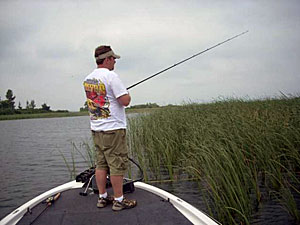
You’ll want to present your lures with the current. Keep your casts from straight upstream to about a 45-degree angle. You can use the current to direct your lure by slowing your retrieve and allowing the current to wash it toward a piece of cover before cranking again. Dragging lures upstream causes them to pendulum away from cover and structure. They also run erratically because you're reeling, and the current washing over them overwhelms the built-in action.
Fishing upstream gives you the best access to where bass will be holding, the downstream side of cover and structure. Sometimes bass may move across the upstream side of a break, but mostly fish will hold on to the downstream side, especially as current speed increases. If you were floating downstream, you would float past prime spots before casting.
Pointing the bow into the current will make boat control easier, too. But that doesn’t mean it won’t work. You may have to run the trolling motor if the current is strong continuously. So make sure the batteries are fully charged.
Rocks rule
River current never stops, so bass find shelter behind structure and cover. But it doesn’t all provide the same protection. If you have the unfortunate luck to be in the path of a tornado, are you going to hide in a straw hut or brick house?
No other cover deflects as much current as rock. That’s why river bass seem to prefer it, and you should fish every chunk you find. It can be in the form of a midriver ledge, riprap bank, or natural outcrop. Bridge abutments count, too. And it doesn’t have to be significant. A rock the size of a truck’s hood can be enough to attract several bass. The one characteristic that will make one rock better than another is how far it rises from the bottom. Taller rocks offer more protection, so concentrate on them when the current is fast.
Wood cover is a close second for river bass habitat. While a single lay down usually can’t break enough current to attract many bass, logjams can. Carefully work them over, making presentations to each piece of wood. Single stumps along the bank can be good, too, especially if you can find enough to fish because you’ll only catch a bass or two from behind each.
Aquatic vegetation grows in most rivers. For example, it has long been an important part of tournament-winning patterns on the Mississippi River. But not just any grass will do. If the current is slow, low-growing eel grass can hold bass. But as it increases speed, search out thicker beds of milfoil and hydrilla or stands of tulles. They have enough density to divert current and form slack water and eddies. When bass are in a neutral mood, such as after a cold front, don’t be afraid to flip a worm or jig into the middle of the grass beds. When they are roaming, it’s hard to beat a crankbait quickly retrieved past the points and pockets on the edge nearest the current. Any cut between two clumps of tulles — or reeds — can also be a prime ambush spot for bass.
Smaller baits are better.
River forage, whether shad, crawfish or even frogs, is smaller on average compared to those in a lake or reservoir. That’s one reason you’ll catch more river bass on little lures. Another reason is they are easier to present in current properly. They have less surface area for current to push against, which upsets their action and your retrieve angles.
Probably the best lure for river bass is a small crankbait. You’ll need deep-divers to bounce off the cover and generate reaction strikes, and a small square bill is perfect for swimming through tree tops and racing through eddies when bass are schooling on baitfish. Spinnerbaits sporting small Colorado or Willow blades, buzzbaits, poppers, and walking baits produce well in rivers. And don’t forget your jigs: flipping, bucktail, grubs, and tubes. Crawfish are a big part of a river bass’s diet, so you must also imitate them.
Smaller doesn’t mean lighter, though. Lighter lures are easily washed away from the spots where river bass hold. If you usually fish a 1/4- or 3/8-ounce jig, for example, try a 1/2- or 5/8-ounce model, and keep the trailer on the small side, such as a Zoom Super Chunk Junior. The same goes for spinnerbaits: Take a heavier model, say ½-ounce, and downsize its blades.
It’s essential to pay attention to lure color. Rivers are stained or muddy more often than lakes and reservoirs. Pick bright colors, such as fire tiger and other patterns that use chartreuse. Rattles also can draw attention to your lures. You’ll want crankbaits that have BBs rather than a one-knocker.
Always biting
River fishing is a peaceful experience, especially when the current is slow. But there are times when you’ll need to exit the main flow and follow the bass to the bank. That’s where they will find shelter — behind even the smallest piece of cover — when rain and runoff turns water high, fast, and dirty.
Even under harsh conditions, river bass seem to be active more often than their cousins in lakes and reservoirs. If you're fishing a lake or reservoir with a river that flows in or out, you can often go there to find bites when bass everywhere else seem to have lockjaw.


